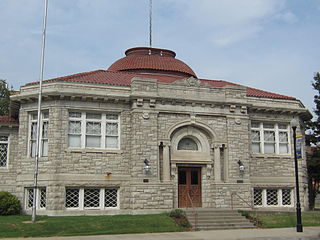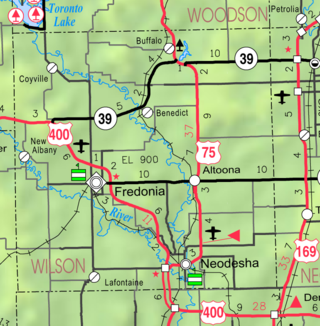
Newton County is a county located in the southwest portion of the U.S. state of Missouri. As of the 2020 census, the population was 58,648. Its county seat is Neosho. The county was organized in 1838 and is named in honor of John Newton, a hero who fought in the Revolutionary War.

Woodson County is a county located in the U.S. state of Kansas. Its county seat is Yates Center. As of the 2020 census, the county population was 3,115. The county was named after Daniel Woodson, a five-time acting governor of the Kansas Territory.

Wilson County is a county located in Southeast Kansas. Its county seat is Fredonia. As of the 2020 census, the county population was 8,624. The county was named after Hiero Wilson, a colonel in the American Civil War.

Neosho County is a county located in Southeast Kansas. Its county seat is Erie. As of the 2020 census, the county population was 15,904. The county was named for the Neosho River, which passes through the county.

Franklin County is a county located in the eastern portion of the U.S. state of Kansas. Its county seat and most populous city is Ottawa. As of the 2020 census, the county population was 25,996. The county was named for Benjamin Franklin, a founding father of the United States. Formerly it was considered part of the Kansas City metropolitan area, but was removed in 2013.

Allen County is a county located in the southeast portion of the U.S. state of Kansas. Its county seat and most populous city is Iola. As of the 2020 census, the population was 12,526. The county was named for William Allen, a U.S. Senator from Ohio and prominent supporter of westward expansion.

Bassett is a city in Allen County, Kansas, United States. It is situated along the Neosho River. As of the 2020 census, the population of the city was 20.

Elsmore is a city in Allen County, Kansas, United States. As of the 2020 census, the population of the city was 50. The name Elsmore is a corruption of Elsinore, where Shakespeare's play Hamlet was set.

Iola is the county seat of Allen County, Kansas, United States. The city is situated along the Neosho River in southeast Kansas. As of the 2020 census, the population of the city was 5,396. It is named in honor of Iola Colborn.

Parsons is a city in Labette County, Kansas, United States. As of the 2020 census, the population of the city was 9,600. It is the most populous city of Labette County, and the second-most populous city in the southeastern region of Kansas. It is home to Labette Community College and the Parsons State Hospital & Training Center.

Tyro is a city in Montgomery County, Kansas, United States. As of the 2020 census, the population of the city was 177.

Erie is a city in and the county seat of Neosho County, Kansas, United States, and situated in the valley of the Neosho River, about a mile Northeast of the river. As of the 2020 census, the population of the city was 1,047.

Altoona is a city in Wilson County, Kansas, United States, along the Verdigris River. As of the 2020 census, the population of the city was 354.

Benedict is a city in Wilson County, Kansas, United States, along the Verdigris River. As of the 2020 census, the population of the city was 69.

Buffalo is a city in Wilson County, Kansas, United States. As of the 2020 census, the population of the city was 217.

New Albany is a city in Wilson County, Kansas, United States. As of the 2020 census, the population of the city was 57.

Neosho Falls is a city in Woodson County, Kansas, United States. As of the 2020 census, the population of the city was 134.

Tompkinsville is a home rule-class city in and the county seat of Monroe County, Kentucky, United States. The population was 2,309 at the 2020 census. The city was named after Vice President Daniel D. Tompkins who served under President James Monroe, for whom the county was named.
Octagon City is a ghost town in Allen County, Kansas, United States. It was a failed intentional community that was founded in 1856 about six miles (10 km) south of Humboldt, Kansas near the Neosho River. It was created by the Vegetarian Kansas Emigration Company, headed by prominent vegetarian Henry S. Clubb and entrepreneurs Charles DeWolfe and John McLaurin. The original intent was to build a vegetarian commune on the south side of the Neosho River, but investor interest in a non-vegetarian moral community was much higher and the decision was made to build Octagon City on the north side of the Neosho River to make the entire project sustainable. Members of Octagon City were under oath to educate their children and uphold a moral lifestyle.
Cofachique is a ghost town situated along the Neosho River near the present-day city of Iola in Allen County, Kansas, United States. Being the first town established in Allen County in 1855, it was the original county seat. However, within five years the greater part of the town was moved to the new town of Iola, while the old site of Cofachique became farm land. The town was named in honor of an Osage chief known as Cofachique, who is said to have been particularly helpful to early settlers, bringing aid to the distressed and homeless. The name "Cofachique" appears to have origins with the Cofachiqui tribe in South Carolina, who were Siouan speakers, and the Osage who settled this area were closely affiliated with the Siouan.


















